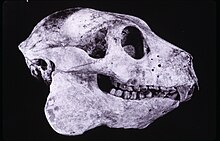
The Cheirogaleidae are the family of strepsirrhine primates containing the various dwarf and mouse lemurs. Like all other lemurs, cheirogaleids live exclusively on the island of Madagascar.

Lemuridae is a family of strepsirrhine primates native to Madagascar and the Comoros. They are represented by the Lemuriformes in Madagascar with one of the highest concentration of the lemurs. One of five families commonly known as lemurs. These animals were once thought to be the evolutionary predecessors of monkeys and apes, but this is no longer considered correct. They are formally referred to as lemurids.

Lemurs are wet-nosed primates of the superfamily Lemuroidea, divided into 8 families and consisting of 15 genera and around 100 existing species. They are endemic to the island of Madagascar. Most existing lemurs are small, have a pointed snout, large eyes, and a long tail. They chiefly live in trees and are active at night.
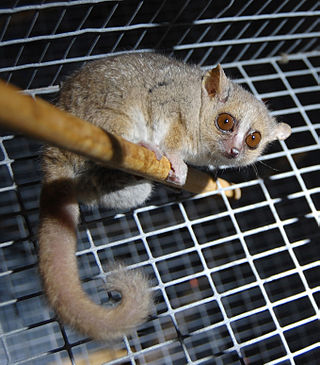
The gray mouse lemur, grey mouse lemur or lesser mouse lemur, is a small lemur, a type of strepsirrhine primate, found only on the island of Madagascar. Weighing 58 to 67 grams, it is the largest of the mouse lemurs, a group that includes the smallest primates in the world. The species is named for its mouse-like size and coloration and is known locally as tsidy, koitsiky, titilivaha, pondiky, and vakiandry. The gray mouse lemur and all other mouse lemurs are considered cryptic species, as they are nearly indistinguishable from each other by appearance. For this reason, the gray mouse lemur was considered the only mouse lemur species for decades until more recent studies began to distinguish between the species.
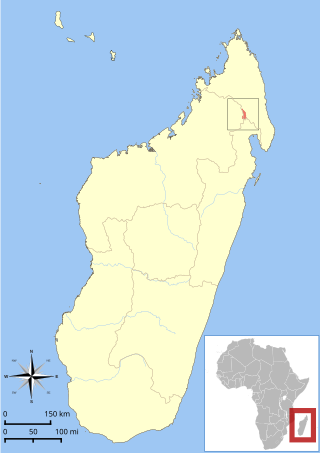
Mittermeier's mouse lemur is a species of mouse lemur known only from Anjanaharibe-Sud Special Reserve in Madagascar.

Madame Berthe's mouse lemur or Berthe's mouse lemur is the smallest of the mouse lemurs and the smallest primate in the world; the average body length is 9.2 cm (3.6 in) and seasonal weight is around 30 g (1.1 oz). Microcebus berthae is one of many species of Malagasy lemurs that came about through extensive speciation, caused by unknown environmental mechanisms and conditions.

Milne-Edwards' sportive lemur, or Milne-Edwards' weasel lemur, is a species of lemur in the family Lepilemuridae. It is endemic to Madagascar. Its natural habitat is subtropical or tropical dry forests. It is threatened by habitat loss.

The northern sportive lemur, also known as the Sahafary sportive lemur or northern weasel lemur, is a species of lemur in the family Lepilemuridae. It is endemic to Madagascar. As a result of severe ecological and human pressures, the lemur is classified as Critically Endangered (CR) by the IUCN Red List.
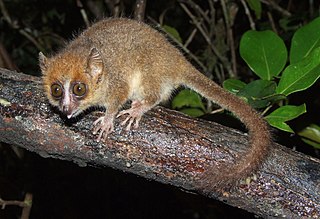
The mouse lemurs are nocturnal lemurs of the genus Microcebus. Like all lemurs, mouse lemurs are native to Madagascar.

The Kirindy Mitea National Park is a national park on the coast of the Mozambique Channel, in south-west Madagascar. The 72,200 hectares park contains many endemic animals and plants and claims to have the greatest density of primates in the world.

Danfoss's mouse lemur, or the Ambarijeby mouse lemur, is a species of mouse lemur endemic to Madagascar. It lives in western deciduous forest within a limited range between the Sofia River and the Maevarano River. This species has been found in substantial populations in the Ambarijevy, Anjajavy, and Beanamaolo forests in Madagascar. Their lifespan is about 5 years but can live up to 10 years. They are part of the infraorder called lemuriformes which represents 20% of the entire primates diversity and over 60% of the mammalian genera of Madagascar.

The sloth lemurs (Palaeopropithecidae) comprise an extinct family of lemurs that includes four genera. The common name can be misleading, as members of Palaeopropithecidae were not closely related to sloths. This clade has been dubbed the ‘‘sloth lemurs’’ because of remarkable postcranial convergences with South American sloths. Despite postcranial similarities, the hands and feet show significant differences. Sloths possess long, curved claws, while sloth lemurs have short, flat nails on their distal phalanges like most primates.

Pachylemur is an extinct, giant lemur most closely related to the ruffed lemurs of genus Varecia. Two species are known, Pachylemur insignis and Pachylemur jullyi, although there is some doubt as to whether or not they may actually be the same species. Pachylemur is sometimes referred to as the giant ruffed lemur, because although it and the living ruffed lemurs had similar teeth and skeletons, Pachylemur was more robust and as much as three to four times larger. DNA studies have confirmed a sister group relationship between these two types of lemur. Like living ruffed lemurs, Pachylemur specialized in eating fruit, and was therefore an important seed disperser, possibly for tree species with seeds too large for even ruffed lemurs to swallow. In the spiny thickets of southwestern Madagascar, they were also likely to have dispersed seeds evolved to attach to fur and be carried away. Unlike ruffed lemurs, the fore- and hindlimbs of Pachylemur were nearly the same length, and therefore it was likely to be a slow, deliberate climber. However, both used hindlimb suspension to reach fruit on small branches below them.

Babakotia is an extinct genus of medium-sized lemur, or strepsirrhine primate, from Madagascar that contains a single species, Babakotia radofilai. Together with Palaeopropithecus, Archaeoindris, and Mesopropithecus, it forms the family Palaeopropithecidae, commonly known as the sloth lemurs. The name Babakotia comes from the Malagasy name for the indri, babakoto, to which it and all other sloth lemurs are closely related. Due to its mix of morphological traits that show intermediate stages between the slow-moving smaller sloth lemurs and the suspensory large sloth lemurs, it has helped determine the relationship between both groups and the closely related and extinct monkey lemurs.
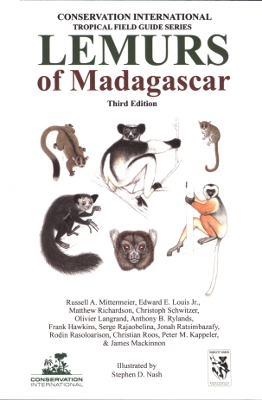
Lemurs of Madagascar is a 2010 reference work and field guide for the lemurs of Madagascar, giving descriptions and biogeographic data for the known species. The primary contributor is Russell Mittermeier, president of Conservation International, and the cover art and illustrations were drawn by Stephen D. Nash. Currently in its third edition, the book provides details about all known lemur species, general information about lemurs and their history, and also helps travelers identify species they may encounter. Four related pocket field guides have also been released, containing color illustrations of each species, miniature range maps, and species checklists.
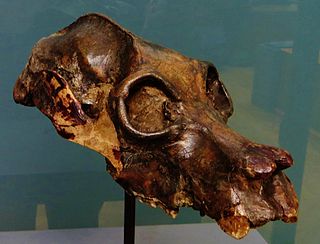
Subfossil lemurs are lemurs from Madagascar that are represented by recent (subfossil) remains dating from nearly 26,000 years ago to approximately 560 years ago. They include both extant and extinct species, although the term more frequently refers to the extinct giant lemurs. The diversity of subfossil lemur communities was greater than that of present-day lemur communities, ranging from as high as 20 or more species per location, compared with 10 to 12 species today. Extinct species are estimated to have ranged in size from slightly over 10 kg (22 lb) to roughly 160 kg (350 lb). Even the subfossil remains of living species are larger and more robust than the skeletal remains of modern specimens. The subfossil sites found around most of the island demonstrate that most giant lemurs had wide distributions and that ranges of living species have contracted significantly since the arrival of humans.

Lemurs were first classified in 1758 by Carl Linnaeus, and the taxonomy remains controversial today, with approximately 70 to 100 species and subspecies recognized, depending on how the term "species" is defined. Having undergone their own independent evolution on Madagascar, lemurs have diversified to fill many ecological niches normally filled by other types of mammals. They include the smallest primates in the world, and once included some of the largest. Since the arrival of humans approximately 2,000 years ago, lemurs have become restricted to 10% of the island, or approximately 60,000 square kilometers (23,000 sq mi), and many face extinction. Concerns over lemur conservation have affected lemur taxonomy, since distinct species receive increased conservation attention compared to subspecies.
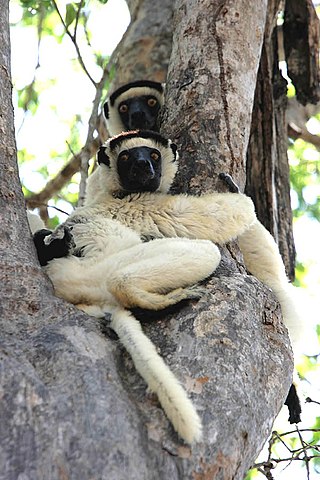
The Kirindy Forest is a private nature reserve situated in western Madagascar, about 50 km northeast of the town of Morondava, near Ambivy. The forest reserve falls within the boundaries of the Kirindy Mitea National Park, which spreads further to the south.
Ganzhorn's mouse lemur is a species of lemur described in 2016. The discovery was made by researchers at the German Primate Center. It was discovered in Madagascar among closely related species such as Madame Berthe's mouse lemur, already described in 2013. Due to their close resemblance, it was initially impossible to identify them as distinct species. It was only after genetic analyses that the species was established. The genetic study was done in collaboration with scientists at the University of Kentucky, the Duke Lemur Center and the University of Antananarivo in Madagascar.


